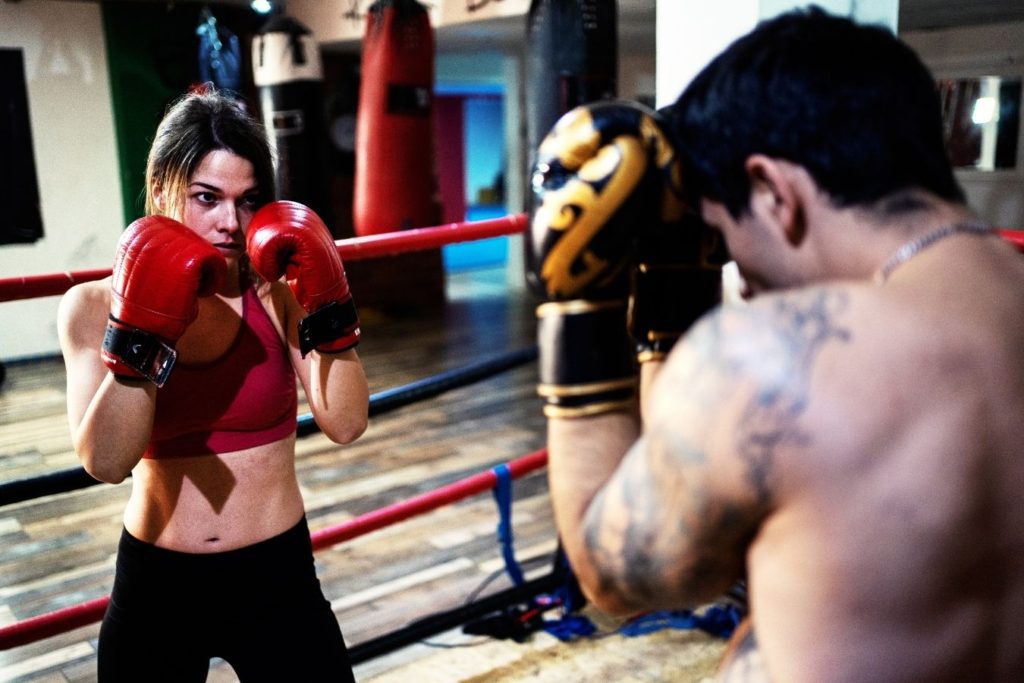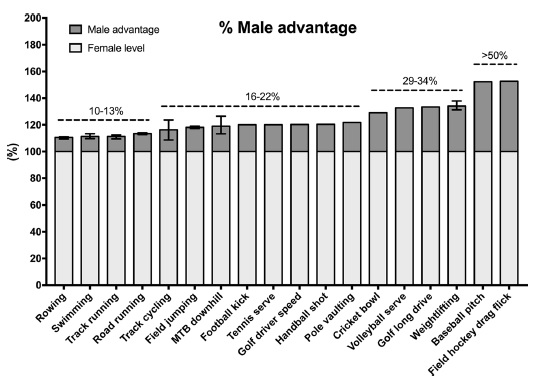Transgender fighters in MMA have been a hot topic especially since it has been covered on the Joe Rogan podcast. There are two sides to transgender athletes competing in MMA:
- they were originally a man so shouldn’t be fighting against women, or
- they identify as female and have had testosterone suppression therapy so they are free to compete against females.
Which side is correct? Is there a middle ground?
Before jumping to conclusions and dismissing any statements as transphobic, the suggestions and conclusions drawn in this article are purely based on scientific data. However, I will be adding my own interpretation and thoughts based on the scientific data otherwise it wouldn’t be Sweet Science of Fighting!
How Does Gender Affect Athletic Performance

By gender, I am referring to the sexes of male and female. Sports that require physical traits to be expressed when competing against an opponent are separated by sex. That is having a male and female division.
Sports that require high levels of strength, or involve combat, are further divided by weight class within each sex division. But why is it that the majority of sports have separate male and female categories?
From the naked eye, you may suggest that males are physically superior to females. How true is this statement?
At the pre-pubescent level, athletic performance between males and females is relatively small but still exists [1]. However, as puberty starts to take its course, athletic performance differences between the sexes become vast.
At 9-years old, males were found to be faster in short sprints by 10%, and over 1 mile by 16.5%, and jumped 9.5% further than 9-year old females [1].

How to Dominate Every Fight with Raw, Explosive Power No One Can Match
Discover the underground blueprint that has quietly turned MMA hopefuls into legends, using nothing but sheer, brute force and bulletproof conditioning techniques.
As puberty hits, male testosterone levels increase 20x while females testosterone levels remain low where males have 15 times higher testosterone levels than females [1]. A normal testosterone range in healthy young males ranges between 7.7-29.4 nmol/L while females generally sit <2 nmol/L (around 1 nmol/L on average) [2].
Some female outliers can have testosterone levels closer to 5 nmol/L [2]. Still well under the normal male range. But what role does testosterone play in athletic performance?
Muscle Mass & Strength

These graphs depict the dose-response relationship of testosterone on various performance markers. Each bar represents the weekly testosterone dose in females with only the largest dose exceeding normal female ranges.
It shows that as the dose of testosterone increases (especially outside the normal female range), lower and upper body power and lean body mass increase significantly. There is also a trend in this set of data for increases in lower body strength.
When taking the data from these females with a circulating testosterone around 7.3 nmol/L, we see large increases ranging from 4.4-26% in these same performance variables.
This is about 50% higher than some of the highest testosterone levels found in females naturally (approximately 5 nmol/L) and 156% greater than the female average. Remember the testosterone level of these females as this will be very important as we move through this article.

The same is seen in men with huge increases in lean body mass, strength, and muscle size as the testosterone dose increases.
With males having 15x the testosterone than females, the dose-response relationship presented in the graphs above would indicate that males are bigger, stronger, and more powerful than females.
This suggests that the elevated testosterone through puberty are primarily responsible for the large discrepancy in performance seen between males and females [1].
In fact, males in the early to middle stages of puberty exhibit testosterone levels far greater than females (6.9 nmol/L) [2]. The increases in muscle mass and strength have also been shown when supplementing testosterone in castrated men where losses in muscle mass and strength are reversed [2].
This difference in muscle mass translates to males having 44% greater upper body strength than females [3].
Lastly, anecdotally, if testosterone had no significant effect on athletic performance, why are multiple athletes getting tested positive for exogenous testosterone every year from a wide variety of sports?
And why do some countries have state-sponsored doping programs? They wouldn’t be throwing money into a performance-enhancing protocol that didn’t bring them results. Especially not continually.
Bone Density
Testosterone also has a positive effect on bone where males have on average 10% more bone than females [3]. More bone equals more surface area to support muscle which is another factor why males have greater muscle mass than females.
Further, on average, males are 7-8% taller than females with longer, denser, and stronger bones [2]. These longer bones allow greater leverage in sports that involve throwing, jumping, and other explosive activities [2].
In fact, the broader shoulders males have allow them to punch harder by generating more torque (rotational force) than females.
Denser bones also have a protective effect for males as females suffer a greater number of lower body stress fractures [2].
Aerobic Conditioning
Males also have a large advantage in aerobic capabilities. Males have a greater lung capacity due to their diaphragm sitting lower, a bigger heart, and a greater ability to carry oxygen through greater haemoglobin concentrations which are all influenced by testosterone [3].
The greater lung volume allows for more air to be inhaled with each breath. Further, testosterone during puberty increases the number of alveoli in the lungs (little air sacs in the lungs) which allows more oxygen to be diffused from the lungs to the bloodstream [3].
The bigger heart allows more blood to be pooled into the heart chamber between each heartbeat, which means more blood can be pumped around the body with each heartbeat. Females on average pump 33% less blood volume compared to males with each heartbeat [3].
Finally, greater haemoglobin concentrations means more oxygen can be carried through the bloodstream meaning more oxygen can be delivered to the working muscles.
Comparing Male And Female Elite Sporting Records
These physical advantages that males have over females are all well and good, but do they translate to the sporting world?

When we compare elite sporting performance (world records) between males and females, the smallest difference in performance is seen in rowing, swimming, and running ranging from 10-13% advantage for males [1].
Jumping events show on average an 18% difference while sports that require a lot of upper body tasks tend to exceed 20% differences favoring males.
Regarding combat sports, vertical jump performance favors males in excess of 40% more than females [1].
Specifically, in the sport of Weightlifting, a pure strength sport, the performance difference between males and females ranges between 31-37% across all weight classes [1]. Even females who are 60% heavier than males do not make up for these strength differences.
Powerlifting takes this a step further with males totaling 65% more than females in the open weight category.
Comparing Male And Female Non-Elite Performance
Similar trends have been observed within the non-elite sporting population too. VO2max has been found to be 12-15% higher in non-elite males than females [1].
Males also have 57% greater muscle size, 109% greater isometric strength, and 89% greater 1RM strength than females.
When measuring arm force and power through a crank device to replicate a punch, males produced 162% more power than females [4].
The least powerful male still produced more power than the most powerful female.
When taking the UFC Performance Institute benchmarks for world-leading performance, bantamweight UFC males have a 17% greater benchmark than female bantamweights in vertical jump performance [5]. Reactive strength shows an even greater discrepancy with a 33% difference favoring males [5].
Maximum strength world-leading performance benchmarks are 32% greater in bantamweight males than females and 6.5% greater for VO2max.
Do Transgender Athletes Have An Unfair Advantage?

When I’m referring to transgender athletes, I’m specifically referring to those who transitioned from male to female.
Before we get to answer the question, we need to understand what ‘tolerable’ fairness is [3]. Sport is not fair.
Those with better genetics, greater access to high-level training, and the financial support to compete at the highest level have a much greater chance of making it to the elite level of sport. The odds are stacked against those with less opportunity.
Those athletes that are taller have a greater advantage in sports such as the high jump compared to shorter athletes, while short-limbed athletes may perform better in sports such as Weightlifting. Further, females with higher natural testosterone levels still compete against other females even though they have an advantage.
These examples would describe what we as a society allow as ‘tolerable’ fairness.
Logically, if athletes can possess these physical or hormonal advantages, then transgender athletes competing in female sports should also fall under a ‘tolerable’ fairness. However, some distinguishing factors would suggest otherwise.
- The IOC guidelines for testosterone limits in transgender athletes is 10 nmol/L, 9x the average female levels [6].
- Female athletes can’t take exogenous testosterone to reach these levels.
- Transgender athletes maintain their pubertal male adaptations even when transitioning to females.
To further assess whether transgender athletes have an unfair advantage, we must investigate how transitioning from male to female affects performance.
The IOC guidelines of transgender athletes having testosterone levels of 10 nmol/L for 12 months prior to competition in order to “minimize any advantage in women’s competition” and to “guarantee fair competition” [6].
The IAAF has further reduced this to 5 nmol/L in order to “ensure a level playing field for athletes” [7]. However, reducing testosterone levels in transgender females doesn’t seem to revert all of the male adaptations derived from puberty.
It has been shown that even after 24 months of testosterone suppression, transgender women maintain bone mass [1]. Bone mass may even be preserved over 12 years which suggests that sporting advantage from increased bone mass would be retained.
No study has reported muscle loss greater than 12% with testosterone suppression, even studies that tested transgender male to females after 3 years of therapy [1]. After 12 months of testosterone suppression, muscle loss is only around 3-5% on average.
Considering males have approximately 40% greater muscle mass than females, this reduction still leaves transgender athletes with a great advantage.
Similarly, a reduction in handgrip strength of 7% and 9% after 12 and 24 months respectively has been found in transgender women [1].
Further, when transgender women had testosterone within a normal female range, a decrease of only 4% in grip strength was found after 12 months of hormone therapy.
This lead to transgender women being in the top 10% of female grip strength scores. Further, transgender women remained 50% stronger than females after 12 months of testosterone suppression in the lower body [1].
Even 3 years after sex reassignment surgery and 8 years of hormone treatment, transgender women are still in the top 10% of females regarding lean body mass and have a 25% stronger grip [1].
These data suggest that strength, lean mass, and skeletal structure are maintained to a higher degree than the average female even in the long term for transgender women giving them a strength advantage.
Unfortunately, no controlled research has investigated the effect of testosterone suppression on endurance performance.
Should Transgender Athletes Compete In Female MMA?
Transgender athletes should not compete in female MMA regardless of their testosterone levels. Transgender athletes retain much of their physical advantages from when they were a male. Based on that alone, I would state that transgender MMA fighters would have an unfair advantage over their female counterparts.
Within MMA, while physical capabilities influence fight outcomes, it is those who possess the greatest skill that often win. Especially as MMA is separated by sex and weight class. MMA is separated by sex and weight class in order to provide fair competition.
It would be deemed unfair to have a heavyweight fight a bantamweight MMA fighter. The outcome of the fight likely isn’t won by who is most skillful as the size and strength discrepancy is too great.
The same applies to transgender women, if she has a much larger advantage in lean body mass and strength over her female opponent, then the transgender MMA fighter may still win even if she isn’t as skillful [3].
Further, there is an inherent risk when placing a transgender woman against a female. Greater bone mass and strength can lead to more severe injuries being inflicted on her female opponent.
Even at the age of 6 years old we see males with 17% greater endurance and can jump 10% further than females [1].
In fact, even the smallest elite sporting gap between males and females of 10-13% would mean that if competitions were mixed, the top females would be pushed outside of the top 1000 athletes due to male performance being far greater even at the sub-elite level.
This also means females would never be able to qualify for sporting scholarships or make any National sports team. All spots would be taken by men, unequivocally.
Sport scientist Ross Tucker has a great article breaking this down further.
If you need further proof, the schoolboy 100m record at age 15 is 10.20 sec. The elite female 100m record is 10.49 sec.
The schoolboy 1500m record at age 14 is 3:48 minutes. The elite female record is 3:50 minutes.
Summary
Based on the totality of the data and the anecdotal evidence, transgender women competing in MMA against other females may not be safe. Creating a transgender division may be the answer. However, to get funding and large contract deals to make it viable might provide difficult.
References
1. Hilton, E. N., & Lundberg, T. R. (2020). Transgender Women in the Female Category of Sport: Perspectives on Testosterone Suppression and Performance Advantage. Sports Medicine, 1-16.
2. Handelsman, D. J., Hirschberg, A. L., & Bermon, S. (2018). Circulating testosterone as the hormonal basis of sex differences in athletic performance. Endocrine reviews, 39(5), 803-829.
3. Knox, T., Anderson, L. C., & Heather, A. (2019). Transwomen in elite sport: scientific and ethical considerations. Journal of medical ethics, 45(6), 395-403.
4. Morris, J. S., Link, J., Martin, J. C., & Carrier, D. R. (2020). Sexual dimorphism in human arm power and force: implications for sexual selection on fighting ability. Journal of Experimental Biology, 223(2).
5. UFC PI. A Cross Sectional Performance Analysis And Projection Of The UFC Athlete.
6. International Olympic Committee. (2015). IOC consensus meeting on sex reassignment and hyperandrogenism. International Olympic Committee.
7. IAAF introduces new eligibility regulations for female classification| News | iaaf.org.

